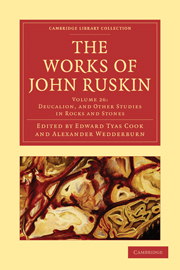Book contents
- Frontmatter
- Contents
- LIST OF ILLUSTRATIONS
- INTRODUCTION TO THIS VOLUME
- I ON THE FORMS OF THE STRATIFIED ALPS OF SAVOY (1863)
- II NOTES ON THE SHAPE AND STRUCTURE OF SOME PARTS OF THE ALPS, WITH REFERENCE TO DENUDATION (1865)
- III ON BANDED AND BRECCIATED CONCRETIONS (1867–1870)
- IV DEUCALION: COLLECTED STUDIES OF THE LAPSE OF WAVES AND LIFE OF STONES (1875–1883)
- V ON THE DISTINCTIONS OF FORM IN SILICA (1884)
- VI CATALOGUES OF MINERALS
- VII THE GRAMMAR OF SILICA (not hitherto published)
- APPENDIX: LETTERS, ADDRESSES, AND NOTES
- INDEX
- Plate section
VII - THE GRAMMAR OF SILICA (not hitherto published)
Published online by Cambridge University Press: 05 March 2012
- Frontmatter
- Contents
- LIST OF ILLUSTRATIONS
- INTRODUCTION TO THIS VOLUME
- I ON THE FORMS OF THE STRATIFIED ALPS OF SAVOY (1863)
- II NOTES ON THE SHAPE AND STRUCTURE OF SOME PARTS OF THE ALPS, WITH REFERENCE TO DENUDATION (1865)
- III ON BANDED AND BRECCIATED CONCRETIONS (1867–1870)
- IV DEUCALION: COLLECTED STUDIES OF THE LAPSE OF WAVES AND LIFE OF STONES (1875–1883)
- V ON THE DISTINCTIONS OF FORM IN SILICA (1884)
- VI CATALOGUES OF MINERALS
- VII THE GRAMMAR OF SILICA (not hitherto published)
- APPENDIX: LETTERS, ADDRESSES, AND NOTES
- INDEX
- Plate section
Summary
FLINT
1. Flint is an impure, but quite definite and distinct condition of silica, collected or secreted out of chalk rocks or the earthy beds connected with them; sometimes in large flat beds or masses, but for the most part in irregular knots and lumps of which the secretion seems in many instances to have been originally provoked by some organic substance.
2. Flint is characteristically black, pale, dull yellow, or grey; the paler kinds opaque, the dark feebly translucent, and these are to be considered the true substance of flint (the paler varieties containing some admixture of clay).
3. The material of flint is so delicate in grain or texture that it can take casts of the most delicate organic structures, but the modes of its secretion and deposition are hitherto undetermined.
4. Its substance is entirely singular among minerals in being so intensely tough in its coherence, though brittle, that it strikes fire easily against steel, and when violently broken it shows no flaws in its mass, and the fractures have curved and zoned surfaces, which from their resemblance to shells are called “conchoidal.” Beautiful examples of entirely conic fracture of this kind will be found in the British Museum. I. F. 9 at Sheffield is entirely illustrative.
- Type
- Chapter
- Information
- The Works of John Ruskin , pp. 531 - 542Publisher: Cambridge University PressPrint publication year: 2010First published in: 1906



